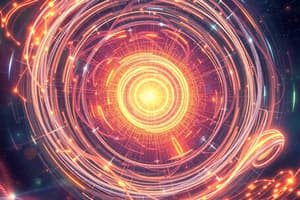Podcast
Questions and Answers
A projectile is fired at an angle into the air. Assuming air resistance is negligible, at what point in its trajectory does the projectile have minimum speed?
A projectile is fired at an angle into the air. Assuming air resistance is negligible, at what point in its trajectory does the projectile have minimum speed?
- Immediately after being fired.
- Just before hitting the ground.
- Halfway between being fired and reaching the highest point.
- At the highest point of its trajectory. (correct)
A car accelerates from rest. Which of the following statements regarding the forces acting on the car is most accurate?
A car accelerates from rest. Which of the following statements regarding the forces acting on the car is most accurate?
- The force exerted by the car on the road is less than the force exerted by the road on the car.
- The force exerted by the engine on the car is greater than the force exerted by the tires on the road.
- The force exerted by the car on the road is greater than the force exerted by the road on the car.
- The force exerted by the car on the road is equal to the force exerted by the road on the car. (correct)
A block slides down an inclined plane at a constant speed. Which of the following statements must be true?
A block slides down an inclined plane at a constant speed. Which of the following statements must be true?
- The component of weight down the plane is less than the force of kinetic friction.
- The component of weight down the plane is equal to the force of kinetic friction. (correct)
- The normal force is equal to the weight of the block.
- The component of weight down the plane is greater than the force of kinetic friction.
Two objects collide inelastically. Which of the following quantities is always conserved?
Two objects collide inelastically. Which of the following quantities is always conserved?
A heat engine operates between two thermal reservoirs at different temperatures. What is the theoretical maximum efficiency of the engine?
A heat engine operates between two thermal reservoirs at different temperatures. What is the theoretical maximum efficiency of the engine?
Which of the following processes always results in an increase in entropy of an isolated system?
Which of the following processes always results in an increase in entropy of an isolated system?
A gas expands adiabatically. Which statement accurately describes what happens to its temperature?
A gas expands adiabatically. Which statement accurately describes what happens to its temperature?
Two objects are in thermal equilibrium. Which of the following statements is most accurate?
Two objects are in thermal equilibrium. Which of the following statements is most accurate?
What is the primary distinction between electric and magnetic fields?
What is the primary distinction between electric and magnetic fields?
According to Maxwell's equations, a changing electric field will induce what?
According to Maxwell's equations, a changing electric field will induce what?
Two parallel wires carry current in opposite directions. What best describes the force between them?
Two parallel wires carry current in opposite directions. What best describes the force between them?
Which of the following best describes the relationship between electric and magnetic fields in an electromagnetic wave?
Which of the following best describes the relationship between electric and magnetic fields in an electromagnetic wave?
What is a direct consequence of wave-particle duality?
What is a direct consequence of wave-particle duality?
According to the Heisenberg uncertainty principle, what is fundamentally limited?
According to the Heisenberg uncertainty principle, what is fundamentally limited?
What is the significance of the Schrödinger equation?
What is the significance of the Schrödinger equation?
What is the core principle of special relativity regarding the speed of light?
What is the core principle of special relativity regarding the speed of light?
What is the effect of gravity on time, according to general relativity?
What is the effect of gravity on time, according to general relativity?
What is the significance of mass-energy equivalence ($E=mc^2$) in the context of relativity?
What is the significance of mass-energy equivalence ($E=mc^2$) in the context of relativity?
According to general relativity, what causes the curvature of spacetime?
According to general relativity, what causes the curvature of spacetime?
Which of the following is a direct consequence of length contraction in special relativity?
Which of the following is a direct consequence of length contraction in special relativity?
Flashcards
What is Physics?
What is Physics?
Studies matter, motion, energy, and forces.
What is Classical Mechanics?
What is Classical Mechanics?
Describes motion of macroscopic objects at speeds much less than light.
Newton's First Law
Newton's First Law
Object stays at rest/motion unless force acts upon it.
Newton's Second Law
Newton's Second Law
Signup and view all the flashcards
Newton's Third Law
Newton's Third Law
Signup and view all the flashcards
What is Thermodynamics?
What is Thermodynamics?
Signup and view all the flashcards
Zeroth Law of Thermodynamics
Zeroth Law of Thermodynamics
Signup and view all the flashcards
First Law of Thermodynamics
First Law of Thermodynamics
Signup and view all the flashcards
Second Law of Thermodynamics
Second Law of Thermodynamics
Signup and view all the flashcards
Third Law of Thermodynamics
Third Law of Thermodynamics
Signup and view all the flashcards
What is Electromagnetism?
What is Electromagnetism?
Signup and view all the flashcards
Faraday's Law of Induction
Faraday's Law of Induction
Signup and view all the flashcards
What is Quantum Mechanics?
What is Quantum Mechanics?
Signup and view all the flashcards
Heisenberg's Uncertainty Principle
Heisenberg's Uncertainty Principle
Signup and view all the flashcards
Quantum Entanglement
Quantum Entanglement
Signup and view all the flashcards
What is Relativity?
What is Relativity?
Signup and view all the flashcards
Special Relativity Postulate
Special Relativity Postulate
Signup and view all the flashcards
Time Dilation
Time Dilation
Signup and view all the flashcards
Mass-Energy Equivalence
Mass-Energy Equivalence
Signup and view all the flashcards
General Relativity on Gravity
General Relativity on Gravity
Signup and view all the flashcards
Study Notes
- Physics is the natural science that studies matter, its fundamental constituents, its motion and behavior through space and time, and the related entities of energy and force.
- Physics is one of the most fundamental scientific disciplines, and its main goal is to understand how the universe behaves.
Classical Mechanics
- Classical mechanics describes the motion of macroscopic objects, from projectiles to parts of machinery, and astronomical objects, such as spacecraft, planets, stars, and galaxies.
- It provides extremely accurate results as long as the objects being examined are large enough to be visible with the naked eye, and the speeds are much less than the speed of light.
- Classical mechanics is a branch of physics concerned with the motion of bodies under the influence of forces.
- Key concepts include displacement, velocity, acceleration, mass, force, momentum, energy, and angular momentum.
- Newton's laws of motion are fundamental principles:
- First law: An object remains at rest or in uniform motion unless acted upon by a force.
- Second law: The force acting on an object is equal to the mass of that object times its acceleration (F=ma).
- Third law: For every action, there is an equal and opposite reaction.
- Conservation laws are critical, including conservation of energy, momentum, and angular momentum.
- Lagrangian and Hamiltonian mechanics provide alternative formulations of classical mechanics.
Thermodynamics
- Thermodynamics is the branch of physics that deals with heat, work, and temperature, and their relation to energy, entropy, and the physical properties of matter and radiation.
- It defines macroscopic variables, such as temperature, internal energy, entropy, and pressure, that characterize the state of a system.
- The laws of thermodynamics govern the behavior of energy:
- Zeroth law: If two systems are each in thermal equilibrium with a third, they are in thermal equilibrium with each other.
- First law: Energy is conserved; the change in internal energy of a system is equal to the heat added to the system minus the work done by the system.
- Second law: The entropy of an isolated system tends to increase over time.
- Third law: As temperature approaches absolute zero, the entropy of a system approaches a minimum or zero.
- Thermodynamic processes include isothermal (constant temperature), adiabatic (no heat exchange), isobaric (constant pressure), and isochoric (constant volume) processes.
- Heat engines and refrigerators are practical applications of thermodynamics, involving the conversion of heat into work or vice versa.
- Statistical mechanics provides a microscopic interpretation of thermodynamic properties in terms of the statistical behavior of a large number of particles.
Electromagnetism
- Electromagnetism is the branch of physics that studies the electromagnetic force, one of the four fundamental forces of nature.
- It explains how charged particles interact through electric and magnetic fields.
- Key concepts include electric charge, electric field, magnetic field, electric current, and electromagnetic waves.
- Coulomb's law describes the force between electric charges.
- Gauss's law relates electric fields to electric charges and magnetic fields to electric currents.
- Faraday's law of induction describes how changing magnetic fields create electric fields.
- Ampère's law relates magnetic fields to electric currents.
- Maxwell's equations are a set of four equations that describe the behavior of electric and magnetic fields and their interactions with matter.
- Electromagnetic waves, such as light, are disturbances in electric and magnetic fields that propagate through space.
Quantum Mechanics
- Quantum mechanics is a fundamental theory in physics that provides a description of the physical properties of nature at the scale of atoms and subatomic particles.
- It is essential to understanding the behavior of systems at the atomic and subatomic levels, where classical mechanics fails.
- Key concepts include wave-particle duality, superposition, entanglement, and quantization of energy.
- The Schrödinger equation describes how the quantum state of a physical system changes over time.
- Heisenberg's uncertainty principle states that there is a fundamental limit to the precision with which certain pairs of physical properties of a particle can be known simultaneously.
- Quantum entanglement is a phenomenon in which the quantum states of two or more objects are linked together in such a way that they must be described with reference to each other, even though the individual objects may be spatially separated.
- Quantum field theory combines quantum mechanics with special relativity to describe the behavior of elementary particles and their interactions.
Relativity
- Relativity is a theory, introduced by Albert Einstein, that revolutionized our understanding of space, time, and gravity.
- It consists of two main parts: special relativity and general relativity.
- Special relativity deals with the relationship between space and time for observers moving at constant velocities.
- Key concepts in special relativity include:
- The speed of light in a vacuum is the same for all observers, regardless of the motion of the light source.
- Time dilation: Time passes slower for moving observers relative to stationary observers.
- Length contraction: The length of an object appears shorter to an observer who is moving relative to the object.
- Mass-energy equivalence: Energy and mass are interchangeable (E=mc^2).
- General relativity extends special relativity to include gravity.
- It describes gravity as a curvature of spacetime caused by mass and energy.
- Key concepts in general relativity include:
- Gravitational time dilation: Time passes slower in stronger gravitational fields.
- Gravitational lensing: Light bends as it passes by massive objects.
- Black holes: Regions of spacetime where gravity is so strong that nothing, not even light, can escape.
- Gravitational waves: Ripples in spacetime caused by accelerating masses.
Studying That Suits You
Use AI to generate personalized quizzes and flashcards to suit your learning preferences.





